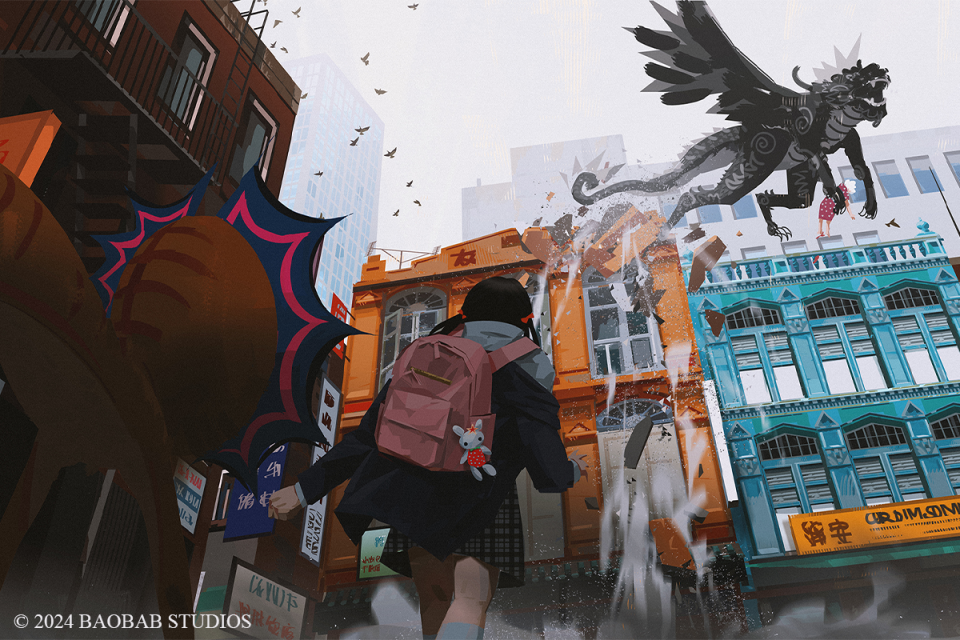‘The Magic Paintbrush’ Debuts in Lit Form Under Unusual Collaboration Between Random House and Franchise-Minded Baobab Studios
- Oops!Something went wrong.Please try again later.

“Madagascar” writer-director Eric Darnell knew he wanted to adapt Chinese folklore about a magic paintbrush for modern audiences from the moment he came across the ancient tale while at DreamWorks, initially developing an animated film inspired by it, then a VR project for Baobab Studios, where he has served as chief creative officer since 2015. But his vision was first realized in decidedly analog form — a children’s book for middle readers.
“The Magic Paintbrush,” now available in bookstores and online under Random House’s Crown Books for Young Readers imprint, is intended as the first work in a platform-spanning franchise that will eventually include TV, film and interactive works in addition to more children’s books. It was developed under an unusual deal brokered between Baobab and the publishing house in 2019: Darnell collaborated with Crown Books for Young Readers VP Phoebe Yeh, who recently edited George Takei’s “My Lost Freedom” picture book, and children’s book author Kat Zhang to ensure the modern-day telling properly honors the folklore that inspired it. Phoebe Zhong, an artist based in Beijing, created the illustrations that fill the book targeted to readers ages 8 to 12.
More from Variety
Momoguro Animated TV Series, Roblox Game in Development From Baobab Studios (EXCLUSIVE)
Baobab Studios Adds Erick Oh, Jony Chandra, Brian Tinsman, Michael McCormick, Hayley Porter
“I knew I needed help,” says Darnell, who early on envisioned the tale as contemporary one about an Asian American girl and the grandmother she didn’t know that well.
The ancient folklore about a paintbrush that brings creations to life had immediate appeal for Darnell when he first encountered it years ago. “As an animation guy, being able to paint something and have it come to life — that’s basically what we do,” notes Darnell, who directed “Antz” in addition to the writing and directing the “Madagascar” movies for DreamWorks before tackling VR projects at Baobab. But he wanted to make an adaptation of the story that would resonate with younger audiences as well.
“It’s one thing to imagine somebody 1,000 years ago stumbling across the magic paintbrush, but what if it was you?” he says. “You were walking home from your school in Port Jefferson on the north coast of Long Island, and stumbled across a magic paintbrush, and anything you drew, they became real. That’s real wish fulfillment.”
Mindful of his own regrets about not learning more about his Oklahoma homesteading grandfather’s rich creative life while he was alive, Darnell was also keen on in building an intergenerational aspect into the story. And there’s a real lesson for young people about responsibility that comes with possessing anything with magic powers, he points out, evoking the Harry Potter literary and movie franchise.
In “The Magic Paintbrush,” written by Zhang with Darnell’s input, an aspiring artist named Amy is forced to stay with her grandmother in Queens when her parents are on a cruise. While there, she discovers Lao Lao’s magic paintbrush that can bring all sorts of creatures — good and bad — to life. Over the course of the book, she learns to stop second guessing her talent and appreciate her grandmother, unbeknownst to her an artist in her own right.
Zhang, who first learned about Chinese magic paintbrush folklore from her father, relished the opportunity to adapt it for contemporary readers, noting the Baobab project already had many elements she loves — fantasy and adventure in addition to painting, which she has done since she was a girl — when she signed onto to write the planned book series.
“For me, the core of this story was a lot about Amy struggling with self-doubt,” Zhang says. “I remember when I was 12 and you’re feeling like you suddenly have to take your art seriously and yourself seriously,” she says. “That can be really paralyzing at any age, but especially for preteens still trying to even figure out who they are in the world.”
Growing up in Georgia, she didn’t see that many children’s books with Asian American characters, but she has since written quite a few, including the Amy Wu series of picture books. She doesn’t consider “The Magic Paintbrush” to be overly focused on Asian issues, however. “It is not specifically about Amy’s struggles being Chinese American or anything like that,” Zhang says. “It’s about her art and it’s the same experience that I think any young artist would be able to see themselves in.”
Zhang, who works as a doctor in the Philadelphia area by day, is now working on a second “Magic Paintbrush” book as Baobab continues to develop the IP for other formats. The company shared concept art for those projects exclusively with Variety for this story.

Baobab, which specializes in interactive animation, also provided some Hollywood sizzle to the book launch in the form of a “Magic Paintbrush” trailer below.
Best of Variety
Sign up for Variety’s Newsletter. For the latest news, follow us on Facebook, Twitter, and Instagram.

